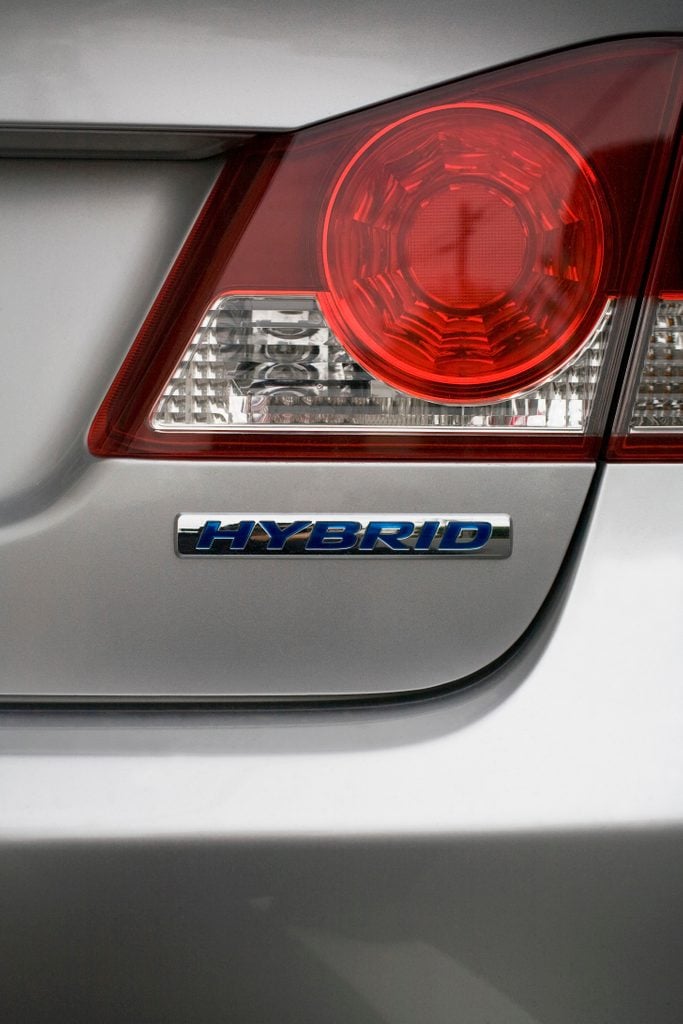The Problem with Hybrid Cars That No One Is Talking About
Updated: Nov. 25, 2022

Hybrid cars are increasingly popular, as they will often save the driver a good bit of money in fuel costs. But there might be a hidden environmental impact to these popular vehicles.
Ever since the first hybrid-electric vehicles hit showrooms right around the turn of the millennium, buyers have been wowed by the seemingly incredible fuel economy given by the combination of a gas engine, an electric motor, and a large battery pack. Celebrities, always conscious of their outsized influence, queued to buy and be seen in the Toyota Prius—a compact hybrid sedan with styling that was unmistakable for anything else.
Indeed, hybrids have become an incredibly popular type of motor vehicle, as over 5 million have been sold over the past two decades according to the United States Department of Energy. You’d think that using less gasoline would a win for the environment—and you’d be right. But there might be a catch. The big battery that makes a hybrid possible might actually be just as bad as burning too much gasoline. These are some of the best fuel-efficient cars.
Hybrid? Electric? EV? Plug-In? What’s the difference?
Let’s line up some definitions here, since we will be primarily dealing with hybrids—but a few other categories of car share some similar components:
- Hybrid: A vehicle that uses both a traditional gasoline engine and an electric motor to drive the vehicle. Sometimes referred to as HEV (Hybrid Electric Vehicle). Examples include the Toyota Prius and Honda Insight, among many others.
- Electric vehicle—often referred to as EV: These vehicles use only electricity to power the vehicle, and thus must be plugged into a charging station or a home wall plug to recharge. A popular example is the entire Tesla lineup.
- Plug-in hybrid: A hybrid vehicle that still has both a gas engine and an electric motor, but also has a charging port to plug into the wall or a charging station. These plug-in hybrids (PHEV for short) have a larger battery than traditional hybrids, and will often allow the vehicle to drive on only electric power for some number of miles before the gas engine automatically kicks in. The Toyota Prius Prime is one example of a PHEV.
What’s in those batteries?
Most modern hybrids and other electrified vehicles use a lithium-ion battery, while older versions used a nickel-metal hydride battery. Both of these battery types use a number of rare-earth metals, which are only mined in certain places on the globe.
Studies have shown that mining for these metals uses a good bit of energy after all, most bulldozers and other mining machines burn diesel fuel—and they require sterile, high-temperature refining processes that use even more energy. It depends on where in the world these batteries are made, but there can be a significant environmental impact in making the battery. Extend the life of your vehicle by avoiding these 15 things you’re doing to your car that a mechanic wouldn’t.
What about refining those rare earth metals?
Many of the materials used in manufacturing lithium-ion batteries tend to be produced in China. An MIT study found that—beyond the impact of the mining process itself—refining these metals tends to use chemicals that will negatively affect the pH of water near the factory. “[S]ome fish can only live in water within a narrow pH range,” the study notes, “and some plants only flower within a certain pH range.”
The study goes on to estimate that Chinese refining techniques produce “1.2 to 1.6 billion cubic meters” of gaseous waste each year. As refining technology and regulation of the industry improve, it is hoped these emissions can be minimized.
So, how does a hybrid or electric vehicle compare to a typical car?
In 2011, the Low Carbon Vehicle Partnership commissioned a report that noted that electric and hybrid cars require many more carbon emissions to manufacture. A typical gasoline-powered car produces around 5.6 tons of carbon dioxide during manufacturing, while a comparable electric car produces 8.8 tons of carbon dioxide—all before it turns a wheel. This is a shocking figure, but one that doesn’t tell the entire story.
After all, once that electric or hybrid car gets into a driver’s hands, it will be using less petroleum than the gasoline-powered car. Over a similar lifespan and including the manufacturing, the hybrid or electric car will create 18 tons of CO2, while the gas car creates 24 tons.
What about electric cars — you have to plug them in, right?
Yes, EVs need to be plugged in—whether an outlet in your garage, or a charging station at the supermarket or other parking lot. The car itself doesn’t create any sort of carbon emissions.
But think about what’s on the other end of that plug. Your electricity could be produced by any number of sources—some of which generate carbon emissions. While wind and solar energy are nearly carbon-free, other sources (including coal and natural gas) of electric power simply move the emissions from your tailpipe downstream to a big power plant.
The U.S. Department of Energy has a nifty tool that lets you estimate the total emissions of your vehicle, based on your state’s typical sources of energy.
What does this mean for the future?
Ultimately, the hybrid or electric car you buy today should be better for the environment than the one you could have bought several years ago, and one you buy in a few years should be better than anything you can buy today.
Technology continues to improve—from more efficient manufacturing processes to less extractive mining techniques to changes in the makeup of batteries. Beyond that, industry and government regulations continue to force battery manufacturers to clean up their efforts. Did you know reusable bags also have a downside?
Sources:
- Alternative Fuels Data Center: “U.S. HEV Sales by Model”
- The International Council on Clean Transportation: “Effects of battery manufacturing on electric vehicle life-cycle greenhouse gas emissions”
- MIT: “Environmental Costs of Refineries”
- Zemo Partnership: “LowCVP study highlights importance of measuring whole life carbon emissions”


